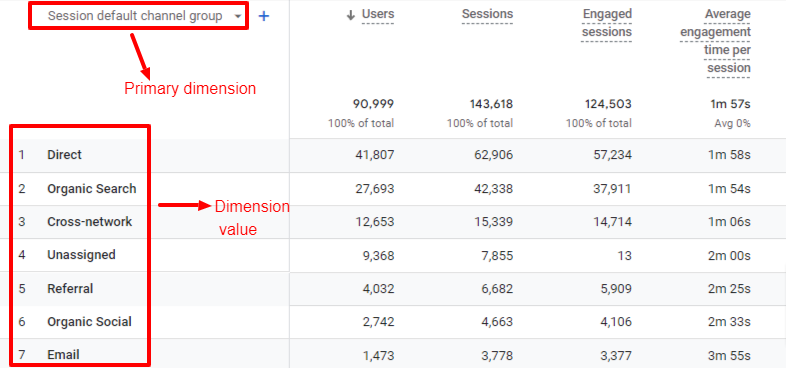Transform Your Analytics Method With Second Measurement in Google Analytics
By integrating additional dimensions right into information evaluation, a new layer of understandings arises, dropping light on complex customer habits and communications. The critical application of additional measurements holds the key to opening a treasure chest of important details that can change how businesses analyze and act upon their information.
Comprehending Secondary Measurements in Google Analytics
Additional dimensions in Google Analytics give added context to main data by enabling individuals to examine metrics throughout a second measurement, supplying much deeper insights right into individual behavior and communications on a site. Secondary Dimension in Google Analytics. While main measurements supply fundamental data points such as pageviews, bounce rate, and session period, second dimensions supply an even more detailed view by segmenting the key information better. This division allows individuals to evaluate metrics in mix with an additional dimension, such as web traffic sources, demographics, or user behavior
Benefits of Making Use Of Additional Measurements
Utilizing secondary dimensions in Google Analytics uses a calculated advantage by enhancing the depth of analysis and providing a much more detailed understanding of user communications and actions on a site. By integrating second dimensions, experts can obtain valuable insights into the efficiency of certain sections or variables within their information. This allows a more in-depth assessment of user actions past surface-level metrics, enabling for a deeper exploration of the elements affecting customer engagement and conversions.

Exactly How to Apply Second Dimensions
When integrating additional measurements in Google Analytics, one vital action is to choose the appropriate metrics and dimensions to improve the evaluation process. To implement additional dimensions successfully, start by accessing your Google Analytics account and navigating to the report you want to enhance with additional information. As soon as in the record, find the "Secondary Measurement" button, normally discovered above the information table. Clicking on this button will certainly open up a drop-down menu listing numerous dimensions that can be included in your primary measurement for much deeper insights.
After choosing the appropriate additional measurement, such as 'Source/Medium' or 'Tool Category,' Google Analytics will certainly show the information in a more in-depth layout, permitting anonymous you to cross-analyze various facets of individual habits. Remember to explore different combinations of second and key measurements to discover useful patterns and trends that can inform your advertising methods. By implementing additional dimensions attentively, you can acquire an extra thorough understanding of your site or app efficiency and make data-driven choices to maximize your digital existence.
Analyzing Data With Secondary Dimensions
Enhance your data evaluation in Google Analytics by incorporating secondary measurements to delve much deeper right into customer actions patterns and optimize your electronic advertising and marketing techniques successfully - Secondary Dimension in Google Analytics. By including second dimensions to your primary data, you can acquire valuable understandings that can help you make notified decisions about your site or application efficiency
Assessing data with secondary dimensions allows you to section your primary information better, offering an extra thorough view of user interactions. Combining the key dimension of 'source/medium' with a secondary measurement like 'landing page' can expose which details web pages are driving traffic from various sources. This info can be crucial in improving your web content method or optimizing your marketing campaign to raise conversions.
In addition, making use of additional measurements allows you to identify connections between various metrics, helping you comprehend the influence of various elements on user behavior. Whether it's analyzing demographics together with customer interaction metrics or tool groups with conversion prices, secondary dimensions encourage you to uncover concealed trends and patterns that can direct your marketing efforts.
Enhancing Efficiency With Secondary Measurements
To improve the performance of data evaluation and decision-making in Google Analytics, integrating additional measurements is vital to enhancing performance metrics and acquiring much deeper insights right into customer habits patterns. By making use of additional dimensions, experts can dig past surface-level information and reveal useful relationships that may or else go unnoticed. This optimization approach makes it possible for organizations to customize their marketing initiatives extra successfully, determine areas for improvement in web site usability, and boost overall individual experience.
Secondary measurements offer a more thorough sight of user interactions by providing added context to main information metrics. Coupling the primary dimension of 'touchdown page' with an additional measurement like 'device classification' can disclose whether particular tools are a lot more likely to drive involvement on particular landing pages. This insight can notify responsive design enhancements or targeted marketing strategies to enhance performance.

Final Thought
In verdict, the assimilation of additional dimensions in Google Analytics supplies services with a powerful device to enhance their analytics approach. Secondary Dimension in Google Analytics. By useful source diving deeper into user behavior and interactions, marketers can uncover important insights that can drive efficiency optimization and enhance the general individual experience. Leveraging second dimensions permits a more detailed evaluation of data, bring about more educated decision-making and customized marketing initiatives
Additional measurements in Google Analytics give additional context to main information by enabling individuals to examine metrics across a second measurement, using deeper understandings right into individual habits and interactions on a website. While key dimensions give fundamental information factors such as pageviews, bounce price, and session period, additional measurements offer a more thorough view by segmenting the main data additionally.One of the vital advantages of using secondary dimensions additional info is the ability to uncover connections and patterns that might not be instantly noticeable when analyzing information with key dimensions alone.When including additional measurements in Google Analytics, one essential action is to pick the relevant metrics and dimensions to enrich the analysis process. Pairing the primary measurement of 'touchdown web page' with a secondary measurement like 'tool classification' can reveal whether particular tools are extra likely to drive involvement on details landing web pages.
Comments on “Secondary Dimension in Google Analytics: Unlocking Advanced Metrics”